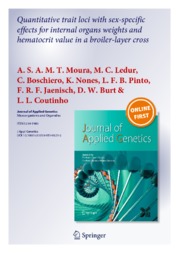Quantitative trait loci with sex-specific effects for internal organs weights and hematocrit value in a broiler-layer cross.
Quantitative trait loci with sex-specific effects for internal organs weights and hematocrit value in a broiler-layer cross.
Autoria: MOURA, A. S. A. M. T.; LEDUR, M. C.; BOSCHIERO, C.; NONES, K.; PINTO, L. F. B.; JAENISCH, F. R. F.; BURT, D. W.; COUTINHO, L. L.
Resumo: Abstract Rapid growth in broilers is associated with susceptibility to metabolic disorders such as pulmonary hypertension syndrome (ascites) and sudden death. This study describes a genome search for QTL associated with relative weight of cardio respiratory and metabolically important organs (heart, lungs, liver and gizzard), and hematocrit value in a Brazilian broiler-layer cross. QTL with similar or different effects across sexes were investigated. At 42 days of age after fasted for 6 h, the F2 chickens were weighed and slaughtered. Weights and percentages of the weight relative to BW42 of gizzard, heart, lungs, liver and hematocrit were used in the QTL search. Parental, F1 and F2 individuals were genotyped with 128 genetic markers (127 microsatellites and 1 SNP) covering 22 linkage groups. QTL mapping analyses were carried out using mixed models. A total of 11 genome-wide significant QTL and five suggestive linkages were mapped. Thus, genomewide significant QTL with similar effects across sexes were mapped to GGA2, 4 and 14 for heart weight, and to GGA2, 8 and 12 for gizzard %. Additionally, five genome-wide significant QTL with different effects across sexes were mapped to GGA 8, 19 and 26 for heart weight; GGA26 for heart % and GGA3 for hematocrit value. Five QTL were detected in chromosomal regions where QTL for similar traits were previously mapped in other F2 chicken populations. Seven novel genome-wide significant QTL are reported here, and 21 positional candidate genes in QTL regions were identified.
Ano de publicação: 2015
Tipo de publicação: Artigo de periódico
Unidade: Embrapa Suínos e Aves
Palavras-chave: Frango de corte, Melhoramento genético animal
Observações
1 - Por padrão são exibidas publicações dos últimos 20 anos. Para encontrar publicações mais antigas, configure o filtro ano de publicação, colocando o ano a partir do qual você deseja encontrar publicações. O filtro está na coluna da esquerda na busca acima.
2 - Para ler algumas publicações da Embrapa (apenas as que estão em formato ePub), é necessário ter, no celular ou computador, um desses softwares gratuitos. Sistemas Android: Google Play Livros; IOS: iBooks; Windows e Linux: software Calibre.
Acesse outras publicações
Acesse a Base de Dados da Pesquisa Agropecuária (BDPA) para consultar o acervo completo das bibliotecas da Embrapa.

